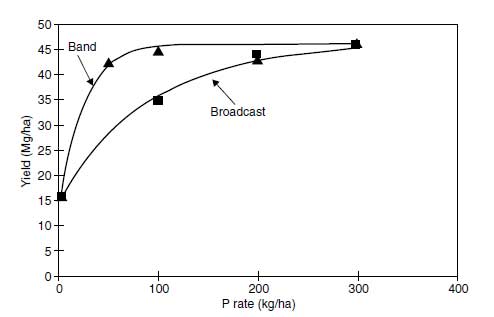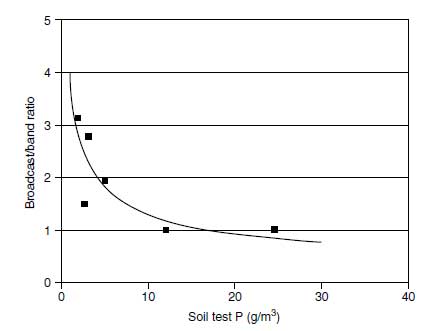Placement of Phosphorus Fertilizers
The literature contains many accounts recording the positive effects of applying phosphorus fertilizer to a localized area, usually near the plant roots, as opposed to a general soil broadcast application. Reviews on the subject of fertilizer placement should be consulted for detailed information (97,98). Localized placement of phosphorus fertilizers might include row, band, or strip placement.It is generally presumed that a localized or band application reduces fertilizer contact with the soil thereby resulting in less phosphorus sorption and precipitation reactions and, thus, enhanced availability to crops. However, for soils with a high phosphorus-fixing capacity, where phosphorus is relatively immobile, placement of the fertilizer where root contact is enhanced may be an equally or more important mechanism than restricting fixation (99–101).
 |
| FIGURE 3.9 Marketable yield of lettuce as affected by phosphorus rate and placement. (Adapted from C.A. Sanchez et al. J. Am. Soc. Hortic. Sci. 115:581–584, 1990.) |
 |
| FIGURE 3.10 Relative efficiency of broadcast to banded phosphorus for sweet corn as affected by soil-test phosphorus level. |
The relative benefits of localized placement of phosphorus fertilizers are neither constant nor universal across crop production situations. This fact is illustrated by a series of experiments that the author conducted to improve phosphorus fertilizer use for vegetable crops produced on Histosols (102,103). The amount of phosphorus required for lettuce production could be reduced by at least 50% if phosphorus was banded instead of broadcast (Figure 3.9). However, band placement was not a viable strategy for improving phosphorus-use efficiency for celery under the existing production system. For sweet corn (Zea mays rugosa Bonaf.), the relative efficiency of banded to broadcast phosphorus depended on soil-test level (Figure 3.10). The relative efficiency was greater than 3:1 (band:broadcast) at low soil-test phosphorus levels but approached 1:1 as soiltest phosphorus approached the critical value. Others have reported a relationship between the relative efficiency of the localized placement of phosphorus and soil-test levels (105-107). Many factors including crop root morphology, length of crop growing season, soil chemical and physical characteristics, and crop cultural practices interact to influence the relative crop response to broadcast or band fertilization.




